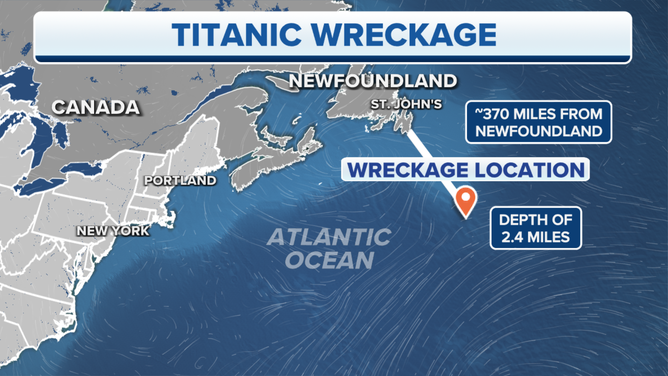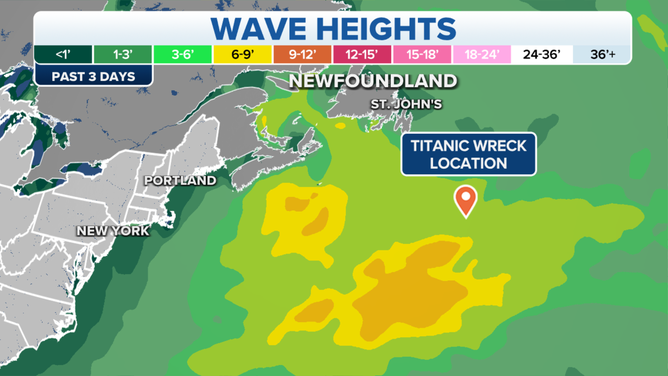Time running out for Titanic tourist submersible missing in rough seas
The submersible lost contact with its support ship less than two hours into a six hour dive.
Titanic tourist submersible missing
FOX Weather's Will Nunley reports the latest news on the missing submersible with five aboard. Three tourists and two crew members made a dive toward the Titanic, 2.4 miles deep, on Sunday morning but lost contact with the support boat less than two hours later.
Time is running out for three tourists, a researcher and one pilot aboard a submersible surveying the Titanic's wreckage at the bottom of the North Atlantic Ocean. The 22-foot submersible only has 40 more hours of life support capability left for the five aboard after it went missing Sunday during rough weather and high seas.
"We were notified yesterday afternoon, and we began immediately to mobilize assets to search both the surface and the water search from the air, and then also launch equipment that would enable us to detect any vessels under the water as well," Rear Admiral John Mauger of the U.S. Coast Guard told FOX News' John Roberts.
The wreckage of the doomed ocean liner sits about 2.4 miles below the surface and 370 miles from Newfoundland, Canada, where the submersible and support boat took off from. That is about 900 miles from Massachusetts, home of Mauger's USCG crew heading up the rescue mission.
HOW THE TITANIC WAS TAKEN DOWN BY A MIRAGE

(FOX Weather)
Billionaire businessman Hamish Harding posted on Facebook on Saturday that he signed on to be a mission specialist/tourist for the expedition. He said a weather window opened up, and the crew was planning to start the dive around 4 a.m. on Sunday.
"The team on the sub has a couple of legendary explorers, some of which have done over 30 dives to the RMS Titanic since the 1980s, including PH Nargeolet," he posted. "More expedition updates to follow IF the weather holds!"
The New York Post confirmed with Harding's family that he is on the expedition.
The support boat that the submersible depends on lost communication with the vessel about one hour and 45 minutes into the dive, according to the USCG. The dive was scheduled to last for six hours and communicate via Starlink satellites.

(FOX Weather)
Rough weather hampering search efforts
Roberts reported that the craft is designed to surface automatically after any malfunction. Failure to do so would suggest a catastrophic failure or possible entrapment.
Rough weather in the area is making the search difficult for both boats and planes searching the surface and below with sonar. A Canadian research vessel, USCG boats and planes and Canadian boats and planes have and will continue to head to the remote area.
"This is a comprehensive approach to try and locate this submersible," Mauger said. "But it is a large area of water, and it's complicated by local weather conditions as well."
The craft is 22 feet long, about the size of a minivan. The submersible is pictured on a platform boat in the Tweet below.
Wave heights during the launch of the submersible through midday Monday were up to 6 to 9 feet. FOX Weather forecasts more reasonable wave heights Tuesday and Wednesday but still at 3 to 6 feet.

(FOX Weather)
Sustained winds have been blowing between 10 and 15 mph Monday, churning up those waves.
At this point, searches are limited to visual searches from planes and boats and "listening" for signs from the the submersible with sonar. The Canadian and American governments are working with private companies to bring in equipment to do a comprehensive sonar survey of the bottom, Mauger said.
"This is on the site of a wreckage, the wreckage of the Titanic. And so there's a lot of debris on the bottom. And locating an object on the bottom will be difficult," said Mauger. "But we will bring all assets to bear that we can to try and find the that submersible and rescue the crew members."

(FOX Weather)
Working tourists
American-owned OceanGate Expedition runs the 10-day trip, eight at sea. The website explains that crew members will take 18 dives off the larger support boat in that time, about 6 hours each or 10 hours "dome closed to dome open."
OceanGate President Stockton Rush talked to FOX Weather's Amy Freeze previously about the expeditions. He said the tourists pay $250,000 each to become "mission specialists." He said this was not a tourist trip because there were no passive members of the crew.
"They receive training throughout four months ahead. We have training sessions, and then on the ship, we will train them on how to operate the sonar, the communication systems, photography, things like that," Rush said. "And so they both fund and participate in the mission."

The bow of the Titanic miles under the sea.
(OceanGate / FOX Weather)
The privately owned company successfully completed over a dozen similar expeditions worldwide, encompassing more than 200 dives. He said Titan was the only submersible that had a toilet.
According to the website, this should have been the fifth Titanic mission of 2023. Harding's post indicated otherwise.
"Due to the worst winter in Newfoundland in 40 years, this mission is likely to be the first and only manned mission to the Titanic in 2023," read the Facebook post.
The legendary Titanic hit an iceberg just four days into her maiden voyage in 1912. It took the lives of more than 1,500 of its 2,224 passengers.
